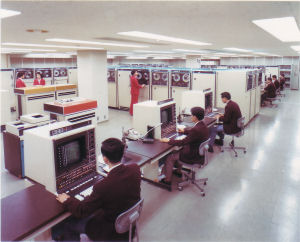|

The most powerful member of the NCR Century family, NCR Century 350 provides superior  performance at lower cost. It is designed for multiprogramming and online/real-time environments for processing scientific as well as general business applications. performance at lower cost. It is designed for multiprogramming and online/real-time environments for processing scientific as well as general business applications.
NCR's development activities in the early seventies, resulted in the successful installation of one of the world's largest on-line banking systems, based on the NCR Century 350, at the Sumitomo Bank of Japan. Sumitomo Bank programmers developed their own system software for the bank needs, separately from the B1/B2/B3 NCR operating system - the TOX operating system for NCR Century-350, a trademark of NCR Japan and Dayton OH, which was a special featured operating kernel for the transaction processing, created under supervision of Ikuo Akiyama.
The system consists of two major computing centers, in Tokyo and in Osaka, between which they control some 190 banking branches and 5,000 terminals, located throughout Japan, on a real-time basis. Seven million customer accounts are being maintained on-line. The system can handle field updates and inquiries through terminals at response times not exceeding five seconds. The Osaka system has a capacity of 300,000 transactions per hour, and the Tokyo system has a capacity of 200,000 transactions per hour. This is one of the largest systems of its kind in the world.
There were two major system product developments associated with this project:
1. The Century 350 mainframe and TOX software: Both hardware and software are oriented towards achieving a high-capacity transaction-oriented system. It also provides for high reliability and several levels of back-up, system flexibility, and an attractive cost/performance ratio. The NCR Century 350 configuration is highly flexible; nine processors can be interconnected in a true multiprocessing environment. With all its excellent on-line capabilities, the system also maintains full compatibility with the standard NCR batch software, which can run concurrently with the on-line jobs.
2. The C-721 Communications Processor: This is a high capacity communications processor, based on NCR's standard minicomputer, which is being used as both a Front End to the C-350 and a Branch Controller for terminals in the bank's branches. This product is available only as a part of a total system offering. An extensive Communications Network System has been installed throughout Japan to effectively control data transmission between terminals and computer centers. Several levels of back-up provide for a highly reliable system.
The enclosed photograph is an artists rendition of the NCR Century 350 installation at the Sumitomo Bank in Osaka, consisting of three Century 350III systems.

The 615-350 was developed specifically for NCR Japan and the TOX operating environment. The overall structure accommodated up to nine 615-300's into a tightly coupled system. The 618-920 memory had only 3 input ports so a new memory was designed. The 618-930 had nine input ports to allow the connection of 3-ports from each of three different 615-300's. There were two 618-930 cabinets of 4 modules each to provide an 8-way interleaved memory system. That resulted in 9 ports going to 8 memory modules which resulted in a 9x8 cross bar. At that time the memory was of such a concern that it was decided to add a memory correction unit. This was the 618-940, and it fit directly in between each of the processor ports and the 8 memory systems. It had a 39 bit architecture, a 32 bit data word and 7 parity bits to manage the Error Correcting Code (ECC), which was called a Hamming Code. The 40th bit was used for a function called "Fetch and Set Lock", which allowed exclusive access by one of the requesting units until they were done with it. The 618-940 added access time to every memory cycle, and it turned out that the mode of core memory failures were not typically bit oriented, so the 618-940's all ended up being disconnected and disposed of. So far we just discussed the tight coupling of three 615-300's. However, you could also tightly couple three sets of three 615-300's, resulting in nine tightly coupled 615-300's. This was accomplished by the "E" units of each of the nine 615-300's going to one 9-port 618-930. This unit was called the system memory. This series of hardware was eventually replaced by the 8500MP systems, possibly the last ones (before the 8600) were the 8585's.
Some technical data:
- 618-920 - Core memory for 615-300. Three input ports and four way interleaved memory 618-930 - Core memory for 615-300/350. Up to 9 input ports and four or eight way interleaved memory. Four ways of interleaving per cabinet, so it took two cabinets to get an 8-way interleaved memory system.
- 618-935 - MOS memory (IC Memory) replacement for the 618-930.
- 618-940 - The Error Correcting Unit (ECU). It went in between the 615-300's and the 618-930's.
|

